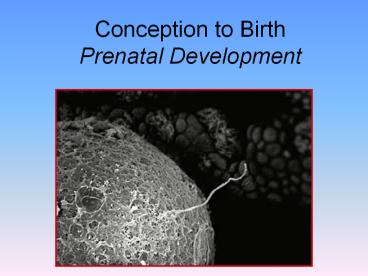Conception to Birth Prenatal Development PowerPoint PPT Presentation
Title: Conception to Birth Prenatal Development
1
Conception to BirthPrenatal Development
2
Prenatal Development
- Prenatal defined as before birth
- Prenatal stage begins at conception and ends with
the birth of the child.
3
Zygote
- A newly fertilized egg
- The first two weeks are a period of rapid cell
division.
4
Embryo
- 14 days until the end of the eight week
- Most of the major organs are formed during this
time. - Heartbeat, Red Blood Cells
Embryo 45 Days
5
Prenatal Development
6
- Prenatal Development Overview
- Zygote Conception to 2 weeks
- Embryo 2 weeks through 8 weeks
- Fetus 9 weeks to birth
7
Fetal Period
- The period between the beginning of the ninth
week until birth - Now referred to as a Fetus
8
Prenatal Development 2 months
9
11 Weeks
10
Placenta
- A cushion of cells in the mother by which the
fetus receives oxygen and nutrition - Acts as a filter to screen out substances that
could harm the fetus
11
(No Transcript)
12
Teratogens
- Substances that pass through the placentas
screen and prevent the fetus from developing
normally
- Includes radiation, toxic chemicals, viruses,
drugs, alcohol, nicotine, etc.
13
(No Transcript)
14
Smoking and Birth Weight
15
Fetal Alcohol Syndrome (FAS)
- A series of physical and cognitive abnormalities
in children due to their mother drinking large
amounts of alcohol during pregnancy
16
(No Transcript)
17
(No Transcript)
18
- Swallowing and Kicking
19
- Make its first movements
20
28 Weeks
21
2-D
22
3-D and 4-D
National Geographic Channel In The Womb
23
(No Transcript)
24
The Beginnings of Life The Newborn
25
Newborn
Reflexes Automatic and Unlearned Responses
- Within the 1st 30 minutes, newborns will turn
their heads to watch a human face even it is a
picture or a drawing - Human Voices
- Taste preferences no spoiled milk please!
26
Rooting Reflex
- Infants tendency, when touched on the cheek, to
move their face in the direction of the touch and
open their mouth - Child is looking for nourishment.
- Sucking Swallowing Reflexes
- Allows for food to be received at birth
27
left leg extends when infant gazes to the left,
while right arm and leg flex inward, and vice
versa.
infant closes its hand and "grips" your finger
takes brisk steps when both feet placed on a
surface, with body supported.
The infant raises up (upper torso, shoulders, and
head) with arms when lying face down (on his
tummy).
28
Newborns are great at grasping
- but not at letting go!
29
- Newborns are able to see, but are nearsighted.
- -prefer faces over other stimuli in the
environment.
- Prefer the sounds of their parents voices over
others
30
Temperament
- A persons characteristic emotional reactivity
and intensity
31
Temperament
- A babys temperament is apparent after just a few
hours of birth - easy babies eat and sleep regularly
- difficult unpredictable, intense, irritable
- Relatively stable personality aspect
32
Physical Development in Infancy and Childhood
33
Infant, Toddler, Child
- Infant First year
- Toddler From about 1 year to 3 years of age
- Child Span between toddler and teen
34
Motor Development
- Includes all physical skills and muscular
coordination - When did you first roll over, sit up, walk, ride
a bike???
35
Motor Development
36
Cognitive Development in Infancy and Childhood
Piagets Cognitive Stages
- Module 4 Prenatal and Childhood Development
37
Cognition
- All the mental activities associated with
thinking, knowing, and remembering - Children think differently than adults
38
Jean Piaget (pee-ah-ZHAY)
- Developmental psychologist who introduced a stage
theory of cognitive development
39
Stage 1- Sensorimotor Stage
- From birth to about age two
- Child gathers information about the world through
senses and motor functions - Child learns object permanence
40
Object Permanence
- The awareness that things continue to exist even
when they cannot be sensed - Out of sight, out of mind
41
Object Permanence
42
Stage 2- Preoperational Stage
- From about age 2 to age 6 or 7
- Children can understand language but not logic
- Fantasy Play
43
Egocentrism
- The childs inability to take another persons
point of view - Includes a childs inability to understand that
symbols can represent other objects
44
Stage 3- Concrete Operational Stage
- From about age 7 to 11
- Child learns to think logically
- understands the concept of conservation
45
Conservation
- certain properties remain constant despite
changes in their form - The properties can include mass, volume, and
numbers.
46
Conservation
47
Conservation
48
Conservation
49
Types of Conservation Tasks
50
Stage 4- Formal Operational Stage
- Child can think logically and in the abstract
- About age 12 on up
- Can solve hypothetical problems (What if.
problems)
51
Assessing Piagets Theory
- Piaget underestimated the childs ability at
various ages. - Piagets theory doesnt take into account culture
and social differences.

